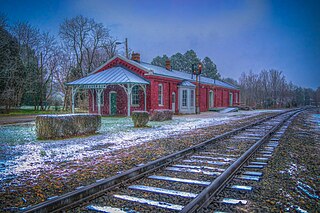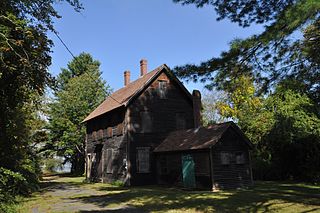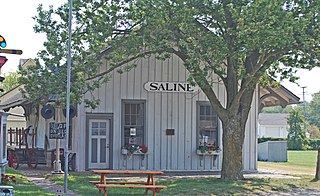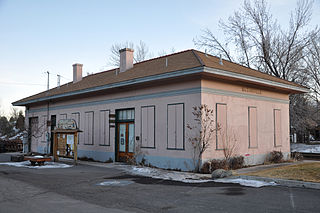Roxbury station is a disused train station on the former Ulster and Delaware Railroad / West Shore "Catskill Mountain Branch" in the hamlet of Roxbury, New York. The station is a contributing property to the Ulster and Delaware Railroad Depot and Mill Complex, a historic district on the National Register of Historic Places.

Joliet Union Station is an inactive Beaux-Arts train station in downtown Joliet, Illinois, built in 1912. Union Station was constructed as part of a large improvement project for the six railroads serving Joliet, which converged on the city as an important rail transportation hub just outside Chicago. At its peak, Union Station served over 100 intercity trains per day, with additional commuter and interurban service.

The Frisco Depot and adjacent Antlers Spring are historic sites in Antlers, Oklahoma, United States. The sites are a part of the National Register of Historic Places, in which they appear as a single entry.

The Chicago and Northwestern Railroad Depot is a railroad station located between Suffolk and Lowell Streets in Ironwood, Michigan. It was listed on the National Register of Historic Places in 1985.

The Chicago, Milwaukee, St. Paul and Pacific Railroad Station, also known as the Milwaukee Road Depot is a railroad depot located at 219 West Fourth Avenue in Menominee, Michigan. It was listed on the National Register of Historic Places in 1982 and designated a Michigan State Historic Site in 1977.

The Nevada–California–Oregon Railway Passenger Station is a historic train station in Lakeview, Oregon, United States. It was built in 1912 by contractor I. A. Underwood from plans by architect Frederic DeLongchamps. It was the northern terminus of the Nevada–California–Oregon Railway. The Southern Pacific Railroad company owned and operated the depot from 1928 until 1975, when it was closed. Since 1978, the building has been used as a law office and later a private residence. Because of its importance to local history, the depot was listed on the National Register of Historic Places in 1983.

Chelsea station is a disused railroad depot located at 150 Jackson Street in Chelsea, Michigan. It was designated a Michigan State Historic Site in 1986 and listed on the National Register of Historic Places in 2010 as Michigan Central Railroad Chelsea Depot. The depot is the only known Michigan example designed by the well known Detroit architectural firm of Mason and Rice.

The Chelsea Commercial Historic District is a historic district located along both sides of Main Street from Orchard to North Street in Chelsea, Michigan; the district also includes the adjacent 100 blocks of Jackson, East Middle, and West Middle Streets, as well as structures on Park, East, and Orchard Streets. It was listed on the National Register of Historic Places in 2011.

Beaverdam Depot is a historic railway depot located at Beaverdam, Hanover County, Virginia.

The Greenback Depot is a former railroad station located in Greenback, Tennessee, United States. Built in 1914 by the Louisville and Nashville Railroad (L&N), the depot served rail freight and passengers traveling in and out of the Greenback area until 1954. Restored for use as a community events center by Ronald Edmondson in the early 2010s, the depot was listed on the National Register of Historic Places in 2013 in recognition of its role in the area's transportation history.

The Newington Railroad Depot is a historic railroad station on Bloody Point Road in Newington, New Hampshire. Built in 1873, it is an unusual railroad-related structure, serving as a passenger and freight depot, and as the residence of the stationmaster, who also performed the role of toll collector for the nearby bridge. It is the only surviving 19th-century railroad-related structure in Newington. Now vacant and owned by the state, the building was listed on the National Register of Historic Places in 2010.
The Former Maine Central Railroad Depot is a historic railroad station on Maine State Route 7 in Brooks, Maine. Built in 1892, it is an extremely well-preserved and little-altered example of a Queen Anne railroad depot. It served as a passenger depot until 1960 and as a freight depot thereafter. It is owned by the Brooks Historical Society. It was listed on the National Register of Historic Places in 2009.

The Chicago and West Michigan Railroad Charlevoix Station is a railroad depot located on Chicago Avenue in Charlevoix, Michigan. It was listed in the National Register of Historic Places in 1995.

The Union Depot is a railway station located at 610 Western Avenue in Muskegon, Michigan. It was listed on the National Register of Historic Places in 2000. It is now the Muskegon County Convention & Visitor's Bureau.

The Pere Marquette Railway Belding Depot is a former railroad station located at 100 Depot Street in Belding, Michigan. It was listed on the National Register of Historic Places in 1997. It is owned and used by the city of Belding.

Charlotte station is a former railroad depot located at 430 North Cochran Avenue in Charlotte, Michigan. It was listed on the National Register of Historic Places in 2000 as Michigan Central Railroad Charlotte Depot. It has been refurbished as a restaurant, and now houses Don Tequilla's Mexican Grill.

The Saline station, also known as the Detroit, Hillsdale and Indiana Railroad-Saline Depot, is a former railroad depot located at 402 North Ann Arbor Street in Saline, Michigan. It was listed on the National Register of Historic Places in 1994. The building now houses the Saline Depot Museum.

The Susanville Railroad Depot is a National Register of Historic Places property in Lassen County, California in the city of Susanville. Originally constructed for the Fernley and Lassen Railway in 1927 to replace an existing station building, it was closed in 1979, and in 1987 it was saved from being burnt by the fire department after local protests, being purchased instead by the Lassen Land and Trails Trust, which uses it for their office as well as maintaining a small museum.

The Michigan Central Railroad Middleville Depot is a former railroad depot constructed for the Michigan Central Railroad. It is located at 128 High Street in Middleville, Michigan. The building was listed on the National Register of Historic Places in 2022.

The Chicago, Milwaukee, St. Paul and Pacific Depot in Canton, Minnesota, United States, is a historic railway station. It was added to the National Register of Historic Places in 2018. The depot was built in 1879 and served the community until 1949, when the tracks were abandoned.




















